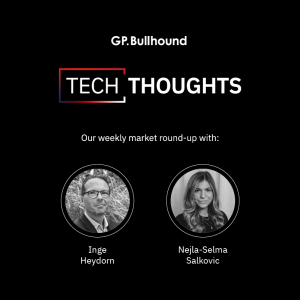Tech Thoughts Newsletter – 24 February 2023.

All eyes on inflation numbers, which are still the clear driver of the market in both directions.
On the tech side, AI is still creating a lot of news flow. Almost every earnings call we were on this week had some reference – we imagine there might have been some quick re-penning of statements to include it (!) but we do believe it will represent a meaningful driver and shift in economic value for many industries – and indeed we do think we’re seeing some impact already in the chip sector (which we think is the key and visible beneficiary).
Portfolio: We have added some weighting around our semi names as we start to see signs of stabilisation on the demand side and improvements on the inventory side. The AI roll out is further helping to drive demand.
AI continues to dominate the headlines – Nvidia and TSMC the key beneficiaries – and it looks like we might be starting to see an impact in the order books/outlooks
- Nvidia (owned) – beat the quarter and guided next quarter higher, with all of their 4 platforms (datacentre, gaming, auto and pro vis) sequentially higher. Nvidia was in quite a tough position in 2022, after PC and gaming had exploded in the pandemic and came crashing back to earth, compounded by the crypto bubble bursting. The set up now – with these events behind us, and AI starting to drive demand – is clearly much better.
- In all the slightly disingenuous AI references, Nvidia is of course the real deal in AI – its software ecosystem CUDA is fast becoming the industry standard in AI and a very effective moat (while it’s free, it also only runs on Nvidia chips..).
- That means it expects datacentre to have troughed last quarter, and to accelerate through the year. While we’ve seen hype before – around metaverse, omniverse – we think this time, AI really is different and believe that enterprises will be looking to increase budgets around AI and that this really will be a meaningful driver of data centre capex this year, of which a big portion should go to Nvidia.
- AI so far has been focused around architectural ideas like Recurrent Neural Networks and sequence learning – effectively instruction sets that dictate how a dataset is analysed. The reality is those learnings are useful but it’s very hard for enterprises to implement them.
- What Nvidia is proposing – which it talked about in this earnings release – is effectively a software suite “AI as a service” solution that makes these learnings accessible through large language models that allow enterprises relatively more easily to define a workload and have that automated with AI – a sort of cloud service business.
- Nvidia is amazingly positioned in AI mostly because it has spent the last several years building up and investing (along with its customers) in the CUDA ecosystem and architecture which as we said, has become a sort of industry standard. CUDA gets rid of a lot of the complexity in writing parallelized software and makes it much easier to implement programs that run on Nvidia GPUs. While there is some threat to be acknowledged in the hyperscalers building their own chips within their specific software stack, the reality is that most enterprises don’t have the capabilities to do this.
- Triton is the alternative to CUDA from OpenAI. Maybe there are parallels here between the ARM and RISC-V threat: CUDA is free and ARM is not. But the fact that CUDA only runs on high margin Nvidia chips might mean the threat isn’t so dissimilar. A discussion we’ll continue to think about.
- The call commentary suggested that the ChatGPT newsflow had impacted order books and interest in Nvidia products: “The activity around the AI infrastructure that we build Hopper and the activity around inferencing using Hopper and Ampere to inference large language models, has just gone through the roof in the last 60 days. And so there’s no question that whatever our views were of this year as we entered the year has been fairly, dramatically changed as a result of the last 60, 90 days….. AI is at an inflection point.. This is the moment we’ve been working towards for over a decade. And we are ready. ”
- Nvidia noted some hyperscalers “recalibrating” cloud capex plans. As per last week’s comments, we believe this is likely more of a timing issue around specific chip and networking products rather than anything more.
- Adoption of the H100 chip has been strong for Nvidia, driven by the much better performance (30x faster inference of transformer-based large language models). It’s also a product that comes with a material price premium. That revenue has now overtaken the old A100 product.
- Not only did Nvidia tick all of the AI boxes, they got the cost cutting memo too and guided for flat operating expenses this year – quite a commitment given last year’s opex line was up 50% yr/yr.
Portfolio view: we’ve spent a lot of time over the last few weeks discussing AI and the winners and losers. For us the business model shifts around AI are still uncertain (how will search as a business model work?). What it definitely means though is that billions of dollars will be spent on chips. As above, Nvidia has the most robust ecosystem and is the obvious incumbent in GPU. There are of course some internal chip efforts from some of the hyperscalers (Google with their TPU, etc). Everyone though will make their chips at TSMC, and the build out of capacity at the leading edge will continue to support the semicap equipment players, most notably ASML.
There’s no doubt there will be more movements into the AI space – this week Amazon announced a partnership with “Hugging Face” an AI company that will allow them to offer an alternative to Azure and OpenAI.
Relatedly, Digitimes reported this week that TSMC’s capacity utilisation for 5/4nm nodes had picked up – and as we commented at the start of February, the January numbers were very strong. Post the Nvidia call we think some of this strength might well relate to the pick up in data centre demand
Cyber security continues to be an area of robust spend
- The real standout results this week for us were Palo Alto (owned) – it continues to execute on every level, and has done an amazing job over the last few years positioning its product set
- Q2 billings growth of +26% yr/yr beat consensus (+22%), they’re raising full year guidance again – now at 22-23% from 20-22%. And they’re raising profitability guidance by 200bps (expecting leverage to continue) and upping FCF. RPO +39%; Next gen ARR +63% (that’s now a $2.3bn business..)
- In the commentary on the call, they gave the view that cyber spend is consolidating around them. In the details they reported more bigger deals (the number of greater-than-$10m deals grew over 140%) which speaks to that vendor consolidation.
- Better operating margin guide is coming partly with the top line, partly with cost control – headcount growth will be the lowest in recent history (and interestingly they committed to bringing share based comp down to drive GAAP profitability – that’s a very big issue for the industry’s path to profitability).
- From the call: “Unlike consumer AI, where we can talk about Sonnets and ChatGPT’s creative capabilities and the revolution that is going to drive in search or advertising, its ability to summarise data and continue to amuse and inform us, the demands from AI and enterprise are far more exacting and so are the returns.”
Portfolio view – Security results have been generally solid across the board so far this quarter (Fortinet, CHKP) but this set of numbers is really showing them as executing over and above the sector and gaining share with a very strong product portfolio. Palo Alto is clearly gaining share with a very strong product portfolio and is further helped as a number of customers are trying to consolidate its supplier base. More broadly in software we are positioned in those best-in-class software stocks which we think at the margin should benefit from consolidation of spend given their platform-like solutions.
Intel (not owned) finally cutting the dividend
- We’ve talked about Intel’s horror earnings this year, the extent to which mistakes over a decade ago are now being borne out by monster share losses, and that Gelsinger’s “do or die” is now to invest in tech leadership. It followed those results with a blanket cut in compensation, still keeping the dividend. It’s possible that Intel thought they needed to keep the dividend to keep investors in the stock, and for some investors that’s certainly true. This week though, they decided (we think rightly) to finally cut the dividend.
Portfolio view – we have no desire to own Intel (we believe AMD will continue to gain share and that its lagging tech situation is going to take many many years to reverse) but the “Invest or die” philosophy Gelsinger is bringing should be very helpful for semicap equipment. We think Intel has just one EUV machine in high volume production – that likely compares with closer to 80 at TSMC. $6bn can certainly buy a few of the ASML machines it needs to catch up…
Demand for digital transformation still strong
- Capgemini beat expectations and guided ahead.
- It saw solid double digit growth across all regions, businesses and almost every sector – tech and retail were called out as the areas under pressure, and financial services (which was the bright spot last year for lots of software businesses) now seeing spend consolidation – something to watch for.
- Bookings +11% and book to bill still standing at a healthy 1.16x
- There’s an acknowledgement of a less supportive macro in 2023 and some deal slippage but much more of an emphasis on the transition to digital which is driving the adoption of their products and services.
- They particularly called out growth in manufacturing and intelligent industry – with areas like auto, aero and life sciences all doing well.
- They’ll continue to increase headcount in 2023 – a key driver of IT services top line growth
- Wise words from Cap CEO on AI: “as with everything like the metaverse, like with all what you hear, there’s a difference between the hype we have at the beginning of the actual applicability in terms of having an impact”
AI – contact center industry an obvious AI use case, driving demand from enterprises
- Five9 (not owned)slightly beat consensus. Subscription revenue grew 32% yr/yr, as they continue to benefit from the long run way of growth coming from the shift to cloud.
- The company is highlighting 3 key tail-winds: on-premise contact center solutions moving to the cloud; digital transformation initiatives to enhance customer experience; and AI/automation which are is a significant catalyst for enterprises to shift to the cloud.
- 41% of RFPs that came into their strategic and enterprise sales organisation cited AI as a reason for issuing an RFP
- It’s not hard to imagine that Chat GPT has given enterprises a very real view into how AI might benefit them from a productivity and ROI standpoint and customer experience/engagement is an obvious use case – and – alongside silicon and chips – third party software/services will likely see significant share of enterprise AI spend.
Walmart/Home Depot and consumer spending points to softness – China still the big unknown
- The consumer side is still weak and not showing many signs of improvement outside the hope of a recovery in China.
- Walmart explicitly called out softness in electronics; Home Depot talking about consumer spend shift from goods to services.
- Etsy and eBay were both relatively better than quite weak expectations – Q4 consumer spending in the US held up relatively well overall (though as above, with shifting trends).
Portfolio view: Our biggest consumer exposure in the portfolio is really Apple. It has through its history shown itself to be pretty resilient to any sort of consumer spend weakness. Though the quarter just reported acknowledged some signs of lengthening upgrade cycles. It still remains to be seen how much iPhone cycles will be impacted by consumer weakness, and really China is still our biggest unknown. TSMC’s reportedly stronger 5nm capacity utilisation we spoke to above is a good sign for them too.
Thinking about the product ramp later this year, there are a lot of rumours around how much silicon volume Apple is buying at TSMC and how large their 3nm volumes will be. We still expect Apple to be the main client of TSMC this year driven by a new 3nm processor which will be used in the new IPhone 15 (we think just the Pro). We have also seen some stories around the fact that the 3nm process could be used in new Macbooks. It’s certainly too early to give a real view on the next product cycle but we keep a close eye on capacity ramps given that will also be a meaningful driver for equipment spend.
For weekly insights on the latest market updates, please subscribe to our Tech Thoughts podcast.
For more information about the latest trends and forecasts, please visit our official Tech Thoughts page.
We provide investors with access to category leading technology companies, globally. Our assets under management have a total value of more than €1bn, and our limited partners include institutions, family offices and entrepreneurs. Learn more about our funds here.
Enquiries
For enquiries, please contact:
Inge Heydorn, Partner, at inge.heydorn@gpbullhound.com
Jenny Hardy, Portfolio Manager, at jenny.hardy@gpbullhound.com
Nejla-Selma Salkovic, Analyst, at nejla-selma.salkovic@gpbullhound.com
About GP Bullhound
GP Bullhound is a leading technology advisory and investment firm, providing transaction advice and capital to the world’s best entrepreneurs and founders. Founded in 1999 in London and Menlo Park, the firm today has 13 offices spanning Europe, the US and Asia. For more information, please visit www.gpbullhound.com.

